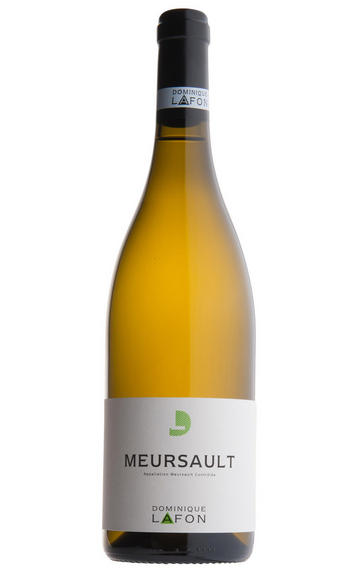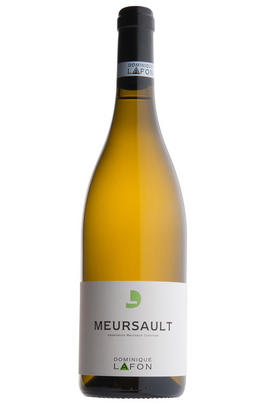
2016 Meursault, Dominique Lafon, Burgundy

Critics reviews
Three barrels instead of seven. This is at a very backward stage, with a somewhat closed nose but showing some signs of future liveliness. Tightly knit on the palate, with citrus notes. Good persistence but not yet singing.
Jasper Morris MW, InsideBurgundy.com (October 2017)
About this WINE

Dominique Lafon
Dominique’s decision, in 2008, to start this parallel project – separate from Domaine des Comtes Lafon – was already an interesting proposition. Now, with his daughter Léa and nephew Pierre beginning to take bigger roles at the family domaine, Dominique may have a little more time to spend on these already splendid wines.
Officially, this is a négociant business, but all the fruit comes from vineyards that Dominique either owns or has the contract to farm.
In the winery
The cellars are rented in the old château in Bligny-lès-Beaune but the same team is used to harvest the fruit for these wines and the Comtes Lafon estate. The winemaking is just the same as well, although the élevage is shorter.

Meursault
There are more top producers in Meursault than in any other commune of the Côte d’Or. Certainly it is the most famous and popular of the great white appellations. Its wines are typically rich and savoury with nutty, honeyed hints and buttery, vanilla spice from the oak.
Even though it is considerably larger than its southerly neighbours Chassagne and Puligny, Meursault contains no Grands Crus. Its three best Premiers Crus, however – Les Perrières, Les Genevrières and Les Charmes – produce some of the region’s greatest whites: they are full, round and powerful, and age very well. Les Perrières in particular can produce wines of Grand Cru quality, a fact that is often reflected in its price. Meursault has also been one of the driving forces of biodynamic viticulture in the region, as pioneered by Lafon and Leflaive.Many of the vineyards below Premier Cru, known as ‘village’ wines, are also well worth looking at. The growers vinify their different vineyard holdings separately, which rarely happens in Puligny or Chassagne. Such wines can be labelled with the ‘lieu-dit’ vineyard alongside (although in smaller type to) the Meursault name.
Premier Cru Meursault should be enjoyed from five to 15 years of age, although top examples can last even longer. Village wines, meanwhile, are normally at their best from three to 10 years.
Very occasionally, red Meursault is produced with some fine, firm results. The best red Pinot Noir terroir, Les Santenots, is afforded the courtesy title of Volnay Santenots, even though it is actually in Meursault.
- 305 hectares of village Meursault. The best vineyards include Clos de la Barre, Tesson, Chevalières, Rougeot, Narvaux
- 132 hectares of Premier Cru vineyards (17 in all). The finest vineyards include Les Perrières, Les Genevrières and Les Charmes
- Recommended producers: Comte Lafon, Arnaud Ente, Coche Dury, Guy Roulot, Jean-Philippe Fichet, Patrick Javillier, François Jobard, Michel Bouzereau
- Recommended restaurant: Le Chevreuil

Chardonnay
Chardonnay is often seen as the king of white wine grapes and one of the most widely planted in the world It is suited to a wide variety of soils, though it excels in soils with a high limestone content as found in Champagne, Chablis, and the Côte D`Or.
Burgundy is Chardonnay's spiritual home and the best White Burgundies are dry, rich, honeyed wines with marvellous poise, elegance and balance. They are unquestionably the finest dry white wines in the world. Chardonnay plays a crucial role in the Champagne blend, providing structure and finesse, and is the sole grape in Blanc de Blancs.
It is quantitatively important in California and Australia, is widely planted in Chile and South Africa, and is the second most widely planted grape in New Zealand. In warm climates Chardonnay has a tendency to develop very high sugar levels during the final stages of ripening and this can occur at the expense of acidity. Late picking is a common problem and can result in blowsy and flabby wines that lack structure and definition.
Recently in the New World, we have seen a move towards more elegant, better- balanced and less oak-driven Chardonnays, and this is to be welcomed.


Buying options
Add to wishlist
Description
This is from a plot known as La Petite Montagne en Chaume de Narvaux, sited above the Goutte d’Or. There is good weight here, with pleasantly ripe stone fruit initially, a rounded mid-palate and then a pleasing freshness to finish. Good persistence, too; this is compact and energetic.
Drink 2020 - 2024
Adam Bruntlett, Senior Buyer, Berry Bros. & Rudd (August 2022)
wine at a glance
Delivery and quality guarantee